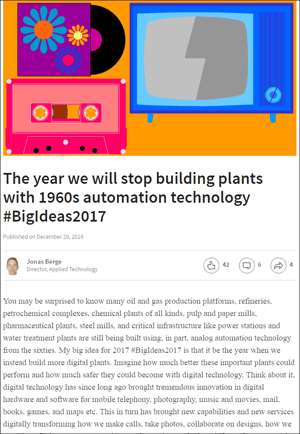 Happy New Year everyone! I hope your holidays were filled with joy, rest and time with family and friends. Let’s open 2017 with a look at a LinkedIn post by Emerson’s Jonas Berge asking if we are ready to stop building plants with 1960s-era automation technology.
Happy New Year everyone! I hope your holidays were filled with joy, rest and time with family and friends. Let’s open 2017 with a look at a LinkedIn post by Emerson’s Jonas Berge asking if we are ready to stop building plants with 1960s-era automation technology.
Jonas opens:
You may be surprised to know many oil and gas production platforms, refineries, petrochemical complexes, chemical plants of all kinds, pulp and paper mills, pharmaceutical plants, steel mills, and critical infrastructure like power stations and water treatment plants are still being built using, in part, analog automation technology from the sixties. My big idea for 2017 #BigIdeas2017 is that it be the year when we instead build more digital plants. Imagine how much better these important plants could perform and how much safer they could become with digital technology.
He notes how these digital technologies have brought big innovations for:
…mobile telephony, photography, music and movies, mail, books, games, and maps etc.
He likens the 60s era introduction of 4-20mA control signals between instrumentation, final control elements and control systems like having a smart phone that could only be used for making calls… hugely limiting.
New digital technologies should not be adopted for technology’s sake, but rather because it:
…enables new tools, and new tools make new practices. This is why digital transformation of how plants are built is so important: improved product quality, plant throughput, energy efficiency, productivity, safety, integrity, and availability as well as reduced maintenance cost and emissions.
Jonas offers a path forward:
The most practical way to connect these sensors is to use industrial networks called “fieldbus” or industrial wireless instead of the analog signals from the sixties. Digital technology enables new innovative sensors and software somewhat reminiscent of smart phones, tablets, and apps to improve plant operation. Time synchronized digital networks allow plants to further improve operation.
He shares examples where process manufacturers and producers have taken these steps, including:
…automation on modern production facilities such as Floating Liquefied Natural Gas (FLNG) vessels.
Jonas also shares an example where a chemical producer uses digital sensors not just for control and safety:
…but also using wireless sensors to monitor the condition and performance of process equipment to improve reliability and energy efficiency.
Now that we’re in 2017, is it time to move beyond 1960s-era technology?





